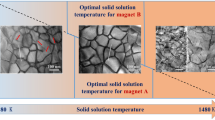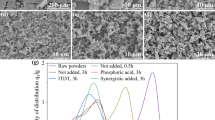Abstract
The oxidation resistance behavior of SmCo (2:17)-type high-temperature magnets modified with Ni–Cr two-layer coating was studied. The study depicts the mass gain kinetics and magnetic properties of uncoated and Ni–Cr-modified magnets oxidized at high temperature (500 °C) in air for 200 h. The oxidation test results illustrate that the mass gain of uncoated magnet is 6.95 mg·cm−2 which is more than that (0.08 mg·cm−2) of coated magnet after 200 h. For the magnetic properties concerned, there is a great loss for uncoated magnet, while for coated magnet, magnetic properties do not change much. The study of uncoated magnet through X-ray diffraction (XRD) and electron probe microanalysis (EPMA) shows that the invasion of oxygen at high temperature leads to the loss of magnetic properties by changing the microstructure of magnet.






Similar content being viewed by others
References
Tang W, Zhang Y, Hadjipanayis GC. Microstructure and magnetic properties of Sm(CobalFexCu0.128Zr0.02)7.0 magnets with Fe substitution. J Magn Magn Mater. 2000;221(3):268.
Guo ZH, Li W. Room-and high-temperature magnetic properties of Sm(CobalFexCu0.088Zr0.025)7.5 (x = 0–0.30) sintered magnets. Acta Metall Sin. 2002;38(8):866.
Richard TF, Rubertus CS. Air force applications of advanced magnetic materials. In: Proceeding of Materials Research Society Spring Conference, Vol 57. San Francisco; 1999. 481.
Richard TF, Rubertus CS. Applications of high temperature magnetic materials. IEEE Trans Magn. 2000;36(5):3373.
Rong CB, Zhang HW, Zhang J, Du XB, Zhang SY, Shen BG. Micromagnetic simulation of the coercivity mechanism in Sm(Co, Fe, Cu, Zr)z magnets. J Appl Phys. 2004;95(3):1351.
Yi JH, Peng YD. Review of research on 2:17 type SmCo rare earth permanent magnets. Rare Met Mater Eng. 2004;33(4):337.
An SZ, Jiang CB. Recent progress in high temperature permanent magnetic materials. Rare Met. 2013;32(5):431.
Liu LL, Jiang CB. The improved oxidation resistance of Si-doped SmCo7 nanocrystalline magnet. Appl Phys Lett. 2011;98(25):252504.
Liu LL, Tingyan J, Jiang CB. High-temperature resistance and magnetic properties of Si-doped Sm2Co17-type magnets at 500 °C. J Magn Magn Mater. 2012;324(14):2310.
Guo ZH, Pan W, Li W. Sm(Co, Fe, Cu, Zr)z sintered magnets with a maximum operating of 500 C. J Magn Magn Mater. 2006;303(2):396.
Liu JF, Zhang Y, Dimitrov D, Hadjipanayis GC. Microstructure and high magnetic properties of Sm(CoCuFeZr)z (z = 6.7–9.1) permanent magnets. J Appl Phys. 1999;85(5):2800.
Chen CH, Walmer MS, Walmer MH, Liu S, Kuhl GE. Thermal stability of Sm-TM high temperature magnets at 300–550 °C. IEEE Trans Magn. 2000;36(5):3291.
Chen CH, Walmer MH, Kottcamp EH, Gong W. Surface reaction and Sm depletion at 550 °C. IEEE Trans Magn. 2001;37(4):2531.
Wang X, Peng X, Zhao H, Guo ZH, Li W, Wang F. High temperature oxidation and its induced coercivity loss of a 2:17 type SmCo-based magnet. J Appl Phys. 2015;117(9):093902.
Liu LL, Jiang CB. Oxidation resistance and magnetic properties of SmCo7-xSix permanent magnetic alloys. J Supercond Novel Magn. 2012;25(1):131.
Saunders SRJ, Nicholls JR. Coatings and surface treatments for high temperature oxidation resistance. Mater Sci Technol. 1989;5(8):780.
Chen CH, Walmer MH, Liu S. Thermal stability and the effectiveness of coatings for SmCo 2:17 high-temperature magnets at temperatures up to 550 °C. IEEE Trans Magn. 2004;40(4):2928.
Chen CH, Huang MQ, John EF, Monnette G, Middleton J, Higgins A, Liu S. Effect of surface modification on mechanical properties and thermal stability of SmCo high temperature magnetic materials. Surf Coat Tech. 2006;201(6):3430.
Wang QY, Zheng L, An SZ, Zhang T, Jiang CB. Thermal stability of surface modified Sm2Co17-type high temperature magnets. J Magn Magn Mater. 2013;331:245.
Pragnell WM, Evans HE, Williams AJ. Oxidation protection of Sm2Co17-based alloys. J Alloy Compd. 2012;517(15):92.
Pragnell WM, Evans HE, Williams AJ. The oxidation morphology of SmCo alloys. J Alloy Compd. 2009;487(1–2):69.
Dong Z, Peng X, Guo ZH, Li W, Wang F. The effect of a surface Cr film on the oxidation of SmCo-based magnetic alloy at 700 °C. Corros Sci. 2013;77:113.
Li JJ, Li AH, Zhu MG, Pan W, Li W. Study on corrosion behaviors of sintered Nd–Fe–B magnets in different environment conditions. J Appl Phys. 2011;109:07A744.
Liu JF, Walmer MH. Thermal stability and performance data of SmCo 2:17 high-temperature magnets on PPM focusing structures. IEEE Trans Electron Devices. 2005;52(5):899.
Kardelky S, Gebert A, Gutfleisch O, Hoffmann V, Schultz L. Prediction of the oxidation behavior of Sm-Co based magnets. J Magn Magn Mater. 2005;290–291(2):1226.
Kardelky S, Gebert A, Gutfleisch O, Handstein A, Wyss U, Schultz L. Corrosion behavior of Sm-Co-based permanent magnets in oxidizing environments. IEEE Trans Magn. 2004;40(4):2931.
Yang Z, Peng X, Feng Q, Guo Z, Li W, Wang F. The mechanism of high temperature oxidation of a SmCo-based magnetic alloy. Corros Sci. 2012;61:72.
Zhao H, Peng X, Yang Z, Guo ZH, Li W, Wang F. Effect of a thin Cr2O3 film on oxidation at 600 °C of a Sm(CobalFe0.22Cu0.08Zr0.02)7.5 alloy. Surf Coat Tech. 2013;226(15):22.
Chen CH, Huang M, Higgins A, Lee D, Liu S. Improved mechanical properties and thermal stability of Sm-Co high temperature magnets resulting from surface modifications. J Iron Steel Res Int. 2006;13(8):112.
Tian JJ, Zhang SG, Que XH. Effects of oxygen and carbon on the magnetic properties and microstructure of Sm2Co17 permanent magnets. Rare Met. 2007;26(4):299.
Zheng J, Lin M, Xia Q. A preparation method and effects of Al–Cr coating on NdFeB sintered magnets. J Magn Magn Mater. 2012;324(22):3966.
Acknowledgements
This work was financially supported by the National Science Foundation of China (No. 51471016) and the Natural Science Foundation of Beijing (No. 2151002).
Author information
Authors and Affiliations
Corresponding author
Rights and permissions
About this article
Cite this article
Bibi, S., Wang, JM., Faisal Rathore, M. et al. Temperature stability of SmCo (2:17) magnets modified by Ni–Cr two-layer coating. Rare Met. 38, 238–244 (2019). https://doi.org/10.1007/s12598-018-1076-0
Received:
Revised:
Accepted:
Published:
Issue Date:
DOI: https://doi.org/10.1007/s12598-018-1076-0




